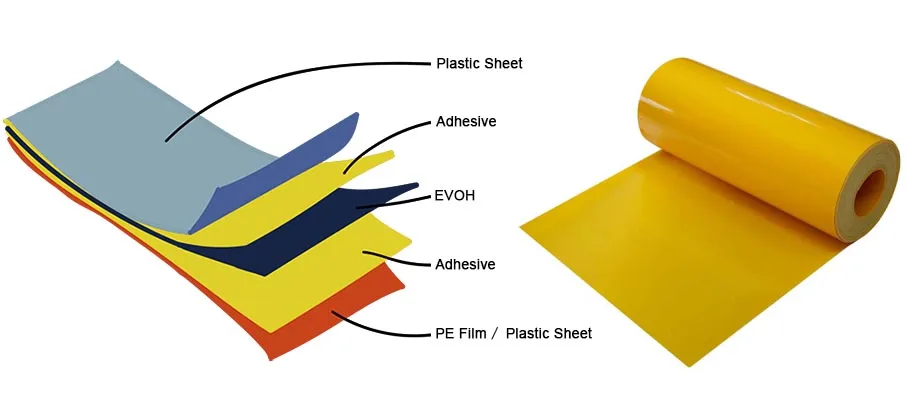Introduction of five common high-barrier plastic films
1. PVA coated high barrier plastic film
PVA-coated high-barrier film is made by coating PVA with nano-inorganic substances on polyethylene film, then printing and compounding. On the premise of not greatly increasing the cost, the technical bottleneck of poor barrier performance of the three-layer polyethylene co-extruded packaging film is solved. PVA coated high-barrier milk film has been fully introduced to the market. Its oxygen barrier rate is less than 2cm3/(m2·24h·0.1MPa), the barrier performance is not only significantly better than EVOH five-layer co-extrusion film, but also the packaging cost is also greatly reduced. This not only ensures all the quality requirements of aseptic packaging for the packaged objects, but also greatly reduces the cost of aseptic packaging for food processing enterprises, and solves the technical bottleneck of poor barrier performance of the three-layer polyethylene co-extrusion packaging film, which can be used for packaging Beverages, juices, milk, soy sauce vinegar, etc.
2. PVDC (polyvinylidene chloride)
PVDC resin is often used as composite material or monomer material and co-extruded film sheet, and is the most used high-barrier packaging material. Among them, the amount of PVDC coating film is particularly large. The PVDC coating film uses polypropylene (OPP), polyethylene terephthalate (PET), etc. as the base material. Due to the high softening temperature of pure PVDC, close to its decomposition temperature, and poor compatibility with general plasticizers, it is difficult to heat and form and it is difficult to directly apply. Most of the PVDC films actually used are copolymers of vinylidene chloride (VDC) and vinyl chloride (VC), and films with particularly good barrier properties made from copolymerization with methyl acrylate (HA).
PVDC (polyvinylidene chloride) is characterized by low permeability, barrier properties and chemical resistance. It is widely used in food, cigarette, beverage preservation and taste separation, as well as moisture-proof packaging in chemical, pharmaceutical, electronic and military industries.
The single-layer PVDC film is produced by biaxial stretch blow molding. It has shrinkage, barrier properties and water resistance. It does not decompose under the condition of microwave heating. It is widely used in household cling film.
PVDC and polyethylene (PE), polypropylene (PP), polystyrene (HIPS) and other synthetic resins are extruded in multiple layers for vacuum dairy products, jams and other packaging. They have good tensile properties and are suitable for larger volumes packaging.
The composite sheet of PVDC, PE, and polyvinyl chloride (PVC) is suitable for the packaging of drugs that are easy to absorb moisture and volatile. At present, many domestic research institutes and manufacturers focus on the research of PVDC and other resin composite lamination film technology and high temperature resistance technology of composite film.
PVDC is used in a variety of substrates such as PE, PP, PVC, polyamide (PA), polyethylene terephthalate (PET), etc. Taking biaxially oriented polypropylene film as an example, the oxygen permeability after coating It is reduced by 1000 times, and the water permeability is reduced by 3 times. The coating can be single-layer or multi-layer. Generally, a single-layer coating of 2.5 μm can have a good barrier effect.
3. EVOH (ethylene/vinyl alcohol copolymer)
EVOH has been the most widely used high-barrier material. In addition to the non-stretching type, the film types of this material include biaxially oriented, aluminum vapor deposition, and adhesive-coated types. Among the biaxially oriented types, there are heat-resistant types for aseptic packaging products. The barrier properties of EVOH depend on the ethylene content. Generally speaking, when the ethylene content increases, the gas barrier properties decrease, but it is easy to process.
The remarkable feature of EVOH is that it has excellent gas barrier properties and excellent processability. In addition, it has excellent transparency, gloss, mechanical strength, stretchability, abrasion resistance, cold resistance and surface strength.
In the field of packaging, EVOH is made into a composite film intermediate barrier, which is used in all rigid and flexible packaging. In the food industry it is used in aseptic packaging, hot cans and retort pouches, packaging of dairy products, meat, canned juices and condiments. In terms of non-food products, it is used to package solvents, chemicals, air-conditioning structural parts, gasoline drum linings, electronic components, etc.
In terms of food packaging, EVOH's plastic containers can completely replace glass and metal containers. Many domestic aquatic companies use PE/EVOH/PA/RVOH/PE five-layer co-extrusion film vacuum packaging for exporting seafood. While accelerating the research of EVOH composite film, the stretching orientation of EVOH is also being studied abroad. The gas barrier performance of the new EVOH film is 3 times that of the existing high-performance non-stretch EVOH film. In addition, EVOH can also be used as a barrier material to coat other synthetic resin packaging materials to enhance the barrier performance.
4. Nylon packaging materials
Nylon-based packaging materials have previously used "nylon 6". However, the airtightness of "nylon 6" is not ideal. There is a nylon (MKD6) which is polycondensed from m-dimethylamine and adipic acid. The air tightness is 10 times higher than that of "nylon 6", and it also has good transparency and puncture resistance. It is mainly used. It is suitable for high-barrier packaging film, and is used for food flexible packaging that requires high barrier properties. Its food hygiene is also approved by the FDA. Its biggest feature as a film is that the barrier property does not decrease with the increase of humidity. In Europe, due to outstanding environmental protection issues, MXD6 nylon is widely used as an alternative to PVDC films. A new type of bidirectionally extensible film made of MXD6 nylon and EVOH, as a high-barrier nylon film. The method of compounding includes multi-layer compounding, and there is also a method of blending and stretching MXD6 nylon and EVOH.
5. Inorganic oxide coating film
The so-called plated film obtained by plating SIOx (silicon oxide) on the film of other substrates has attracted more and more attention in the market. In addition to the silicon oxide film, there is also an aluminum oxide vapor-deposited film. Its air tightness is the same as that of the silicon oxide coating obtained by the same method.
Multi-layer compounding, blending, copolymerization, and evaporation technologies have developed extremely rapidly. High-barrier packaging materials such as ethylene vinyl alcohol copolymer (EVOH), polyvinylidene chloride (PVDC), polyamine (PA), polyethylene terephthalate (PET) multilayer composites and silicone compounds Evaporated films, etc. have been further developed. Among them, MXD6 polyamide packaging materials and silicon oxide evaporation films are particularly attractive.
Relative News
- ESD PET sheet: ITO coating vs antistatic additives
- Why can ESD plastic trays protect electronic prod…
- How to choose between virgin PET sheet and RPET s…
- What kind of blister sheet can be used to make tr…
- Black conductive HIPS plastic sheet roll shipped …
- PULIXIN packaging materials unveiled at Chinaplas…
- PP blister sheet: an environmentally friendly, sa…
- PET blister sheet: transparent protection, fresh …
- PET plastic sheet rolls set sail to help upgrade …
- Key features of our HIPS plastic rolls
